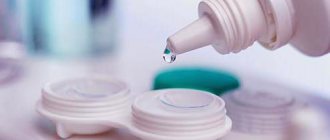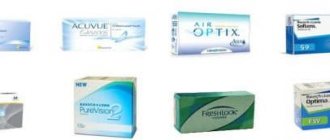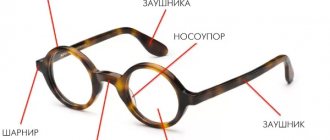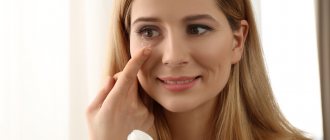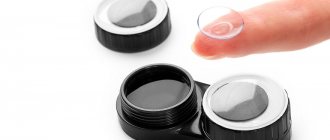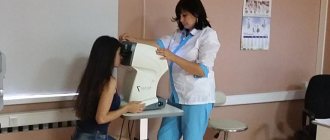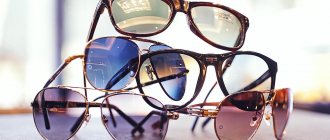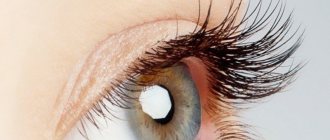Center-to-center spacing (MC) is the distance between the pupils, measured in millimeters.
A person's eyes are at a certain distance from each other, which may vary.
The gap between the center of one pupil and the other is called intercenter. As a rule, it is in the range of 54–65 mm. As children grow, their MR continues to change, but once they become adults, the growth of the eyeball stops, this value remains constant.
A recipe can have one MP value or two. This is an important parameter for purchasing appropriate glasses. It is very important that the lenses are directly focused on the pupils so that the person can enjoy proper vision.
Why measure the distance between the pupils?
In men, the average pupillary distance is 64.0 mm, in women - 61.7 mm, and a distance of 54.0-68.0 mm is considered normal for both sexes. Children have MR, which depends on age, gender and development.
MR measurement is necessary for the correct selection of corrective optics. Each set of prescription lenses has an optical center, which is determined by pupillary distance. The centers of the optical glass must coincide with the centers of the pupils so that the visually impaired patient can see as clearly as possible.
The patient may have a violation of the asymmetry of the holes in the iris of the eye, so ophthalmologists have a definition of binocular and monocular distance.
Binocular distance is the segment between both eyes. It is equal to the sum of 2 monocular measurements. Monocular span is the measurement from the center of the top of the nose adjacent to the forehead to the middle of the opening in the iris.
Measuring MR helps to avoid the following problems when wearing vision correction devices:
- incorrect identification of the picture;
- blurred image;
- double vision;
- intolerance and asthenopic symptoms.
The key to successful correction
Regardless of whether we are talking about an adult or a child, accurate lens centering is of great importance. Their optical centers must match the centers of the pupils, otherwise it may lead to unpleasant consequences such as headaches or blurred vision. It is also worth keeping in mind that the centering of the lenses is disrupted if the glasses move off the nose. In addition, children have the ability not only to grow, but to grow in leaps and bounds - “in one summer,” as some parents say. In one year, a child’s interpupillary distance can change by 2 mm - accordingly, the center of the lens will shift by the same number of millimeters. Taking this into account, it is recommended to visit a specialist who will re-adjust the fit of glasses for a young bespectacled person and check whether he has “grown out” of them, at least once a year. If the center-to-center distance has changed, then it will be necessary to replace the old spectacle lenses with new ones. Replacing the frame, provided it is intact, will not be necessary in this case.
It is recommended to visit a specialist who will re-adjust the fit of glasses for a young bespectacled person and check whether he has “grown out” of them at least once a year
Formula for measurement
The ease of use of an optical device depends on the correct selection of optical glass and rim. Precise centering ensures the necessary quality of improvement in visual perception and rapid adaptation of the visual organs to the new optics.
The form issued by an ophthalmologist or optometrist to obtain a correction means indicates the center-to-center distance. If there is asymmetry, it is important to take this indicator into account when producing individual diopter glasses. Many experiments carried out have discovered a possible amount of prismatic action that will not cause unpleasant symptoms in the case of high asymmetry.
Determined by the formula: Δ= C x Fv'. From which it follows that the higher the refractive power of diopter glass, the more the optical center at the point does not coincide with the geometric center of the optical or central zone.
When an optician's salon takes an order from a client, patients often need MR parameters taking into account asymmetry in the location of the eyes.
Frames for older children
Children have to look up much more often than adults, so it is advisable for the top of the child's frame to be level with the bottom of the eyebrows to minimize the possibility that the child will look over the glasses when raising their head. The lower border of the frame should fall on the fold separating the skin of the lower eyelid and cheeks. Thus, the eyebrows remain open, which is important for the development of the child’s facial expressions, and at the same time the frame does not lie on the cheeks. Children's metal frames often come with silicone nose pads that can be adjusted to fit your child's nose. It is only important that the manufacturer does not use “adult” nose pads for children’s frames, which are too long for children’s noses.
Algorithm for measuring interpupillary distance
Tool - millimeter ruler, mirror. Algorithm for self-determination of MR:
- stand opposite the surface reflecting the image;
- lean the geometric device against your forehead, hold it horizontally, straight;
- cover the right organ of vision with your hand, align the ruler with the center of the left pupil;
- look straight, close the left one and open the second one;
- look at the parameters that coincide with the center of the right eye.
If a doctor or friend is measuring, stand opposite, but so that your head is several cm lower than the doctor’s head. The distance is 200 mm. The one undergoing the MR determination looks over the doctor’s head.
Double MR consists of two numbers and represents the distance between the centers of each pupil to the bridge of the nose. It is written in the recipe: 33/31.
Optometrists measure MR using a pupillometer. This is a quick, painless measurement. The device guarantees high accuracy. Determines the MR of each organ of vision, displays the measurements on the screen, movements of the pupils do not affect the accuracy.
Pupillometry is not performed on patients with a deviated nasal septum, severe visual impairment, or torticollis.
How does it work:
- Place the nasal pad on the subject’s nose and ask him to hold it like binoculars;
- set the gap on the wheel to infinity;
- look and measure the gap.
In emergency departments, examination is performed using a pupillometer, a clinical parameter for monitoring the patient. Automated devices provide more advanced and accurate results. More often used for patients with brain injuries, less often for patients who need a prescription for glasses.
What is binocular interpupillary distance?
Interpupillary distance PD, the value indicated in your glasses prescription, is the length of the space between the pupils. Quite often, the pupils are located asymmetrically relative to the middle of the bridge of the nose, so ophthalmologists record data for each eye. Binocular RC is the distance between the centers of the pupils. Monocular RC is the distance from the center of the bridge of the nose to the center of the pupil. So, if the center-to-center gap is 63 mm, then for each eye the values can be indicated as 31 mm and 32 mm - the distance from the center of the bridge of the nose to the eyes. In adults, such data remain practically unchanged, but in children, due to growth processes, they are adjusted. For this reason, using outdated prescriptions for children's glasses is unacceptable.
How can you measure interpupillary distance? The modern approach to the method of measuring the center-to-center gap has been slightly changed: past errors have been taken into account, and priorities for new equipment have been determined. If previously it was customary to indicate the difference in the interpupillary distance for near and far as 2 mm, now, as a rule, the difference is 4-6 mm. Also, now the distance can be displayed in any number, and not just divisible by two, as was recommended by the old standards. Previously, recipes indicated two distances. For example, 60-62 mm, where a smaller value should have been used for viewing close objects, and a larger value for distant objects.
It is currently accepted that the interpupillary distance for distance and near can differ by 3-7 mm.
The distance for the lower segments in bifocal and progressive lenses of complex design is 2.5 mm less for the right and left eye than the distance for the distance.
Algorithm for determining the position of the pupil in the rim opening
Measuring process:
- The patient sits opposite the doctor.
- Looks straight, does not change the position of the head.
- The subject is put on glasses so that the visual organs are at the same level as the optics.
- The doctor takes the measurement from a distance of 40 cm. During the examination, the patient should not move, turn his head or pupils.
- First, the right organ of the subject is closed, and the center of the pupil is marked on a false template. Then the left organ is closed and the center of the right pupil is marked.
During the examination, the ophthalmologist and optometrist should remain at the same vertical level. If a person covers his eye during an examination, the optician does not have a false template; a measuring plate is used.
The measuring plate is placed in the lower opening of the rim. The subject sits upright, looking straight into the distance. This way the vertical position of the eye is determined.
Another way to determine MR is to use a special device from Essilor. The device is attached to the frame of glasses. The doctor then rotates the handles on both sides. Thanks to them, the plate begins to move when it reaches the center of the eye, and the vertical coordinate is determined.
How to measure interpupillary distance
You can find out your interpupillary length in three ways: using a millimeter ruler, resorting to the help of a loved one, and also by consulting a doctor. Only an ophthalmologist can professionally measure MR using a special device - a pupillometer.
Ruler
To find out your MP indicator, you need to take a ruler with millimeter divisions. In this simple way you can obtain indicators of the binocular and monocular interval. If you don’t have a ruler, you can download the scale from the optician’s website and print it out.
You can measure the distance between the pupils using a ruler as follows. The person stands near the mirror, at a distance of 20 cm. The head should be kept level, placing the instrument parallel to the eyebrows, above the eyes.
Covering the right eye, place a ruler with a zero in the middle of the left pupil. Next, measure the length to the middle of the right pupil, opening the right eye. To ensure the accuracy of the result, the measurement is repeated several times.
Pupilometer
A pupillometer is a device used to measure MR, as well as pupil diameter.
You can determine the interpupillary length using a pupillometer at an appointment with an ophthalmologist. Externally, this device looks like binoculars, the client is asked to look through the eyepieces while the specialist takes measurements.
The device is placed on the bridge of the patient's nose. The patient needs to fix his gaze on the light spot, while the ophthalmologist is located opposite the patient at the same level and sees his eyes. The doctor advances the sliders until they coincide with the reflex. The measurement result is displayed on a digital display.
Among the advantages of using the device:
- measurement accuracy with insignificant error;
- the ability to take measurements for each eye;
- reliable result, which is not affected by the intensity of light in the office, pupil mobility and other factors;
- the interval between the pupils is given in digital form;
- The procedure makes it possible not only to measure MR, but also to identify eye asymmetry.
Pupillometry is not suitable for patients who have a deviated nasal septum, impaired vision, torticollis, or small children.
In addition to the interpupillary length, the ophthalmologist can conduct additional studies: examine the retina of the eyes, check the condition of the muscles, and also check visual acuity.
With the help of another person
The interpupillary distance can be measured by asking a friend or loved one for help.
To do this, you need to stand at a distance of 20 cm facing each other. The person checking should sit down, and the person being checked should look exactly above his head, without making any rotations with his eyes. The length is measured using a ruler. Having fixed o in the middle of the left eye, determine the interval to the central part of the pupil of the right eye.
Useful video
A modern approach to measuring interpupillary distance thanks to new technologies in ophthalmology:
Author's rating
Author of the article
Alexandrova O.M.
Articles written
2029
about the author
Was the article helpful?
Rate the material on a five-point scale!
( 3 ratings, average: 5.00 out of 5)
If you have any questions or want to share your opinion or experience, write a comment below.
Interpupillary distance for distance and near - measurement methods
When measuring near distance, a specialist must take into account convergence (the physiological ability of the eyes to bring the visual axes together on an object). Near PD measurements are taken from the outside of the iris of the right eye to the inner edge of the limbus of the left eye. The doctor's leading eye is located opposite the center of the patient's nose bridge, at the same level. The gap between the eyes of the doctor and the person being examined is forty centimeters.
Comfortable binocular vision is ensured by the correct lens - the difference between the center of the pupil for distance and the center of the pupil for near.
Inset is important when creating a prescription for progressive glasses. When measuring the interpupillary distance for distance, the fixation point is located at a distance of 70 cm from the patient, 4-5 cm above the doctor’s head. When taking measurements for distance, a pupillometer has significant advantages, minimizing various errors. Thus, compared to the measuring method with a ruler, the pupillometer has 3 times fewer errors.
Self-measurement of pupillary distance
You can measure the distance yourself, but doctors do not recommend doing this. Data may be incorrect. You can get reliable results only after consulting an ophthalmologist. He uses special equipment that allows him to obtain reliable results. After this, a prescription for purchasing glasses or other optical products is determined. But if you need to get PD data, then you can do it in a simple way. To do this you will need the help of a loved one and a millimeter ruler.
The person should hold it between their thumb and index finger, with their free fingers facing your face. Then you should close your right eye and look at the other person's left eye. It should align the zero mark with the edge of the iris of your right eye. Then such manipulations are carried out with the left eye.
Children's glasses lenses
Due to active play and sports, children are at greater risk of eye injury than adults. To ensure that the glasses themselves do not cause injury, they must be made of impact-resistant materials. Children's glasses should have plastic rather than glass lenses. polycarbonate and Trivex have the greatest resistance to impact loads - they are lightweight, durable and represent the optimal combination of comfort and safety. In addition, lenses made from these materials protect the eyes from UV radiation. Some opticians work only with polycarbonate when selecting children's glasses, others prefer Trivex, especially if the refraction does not exceed 3.00 diopters. Many manufacturers produce lenses for children from these materials with the most scratch-resistant optical coatings, because many young clients do not always handle glasses carefully. It should be understood that the higher the quality of the optical coating, the more expensive the lenses will be. In addition to preventing injury from chipped lenses and broken frames, children should also be protected from: - ultraviolet radiation; — excessive exposure to solar radiation (“ Risk of excessive exposure to solar radiation ”); — interfering glare of reflected light*; - exposure to blue light emitted by artificial lighting sources - energy-saving compact fluorescent lamps, which are often equipped in classrooms, and LCD screens of electronic devices. _______________ * For this purpose, lenses with anti-reflective coating are recommended for children.
Other related articles:
